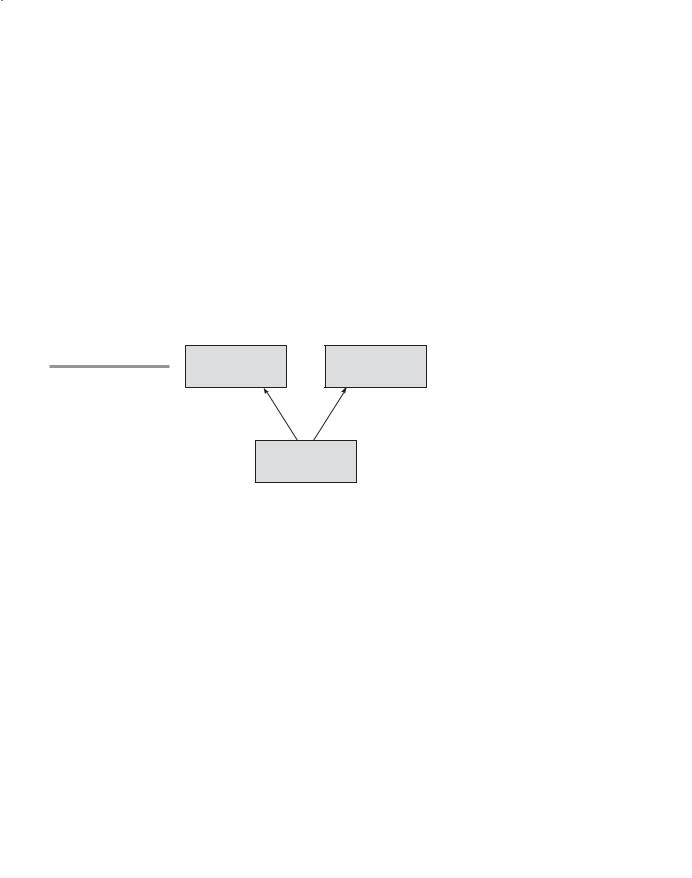
- •New to the Tenth Edition
- •Preface
- •Acknowledgments
- •About the Author
- •Contents
- •1.1 Reasons for Studying Concepts of Programming Languages
- •1.2 Programming Domains
- •1.3 Language Evaluation Criteria
- •1.4 Influences on Language Design
- •1.5 Language Categories
- •1.6 Language Design Trade-Offs
- •1.7 Implementation Methods
- •1.8 Programming Environments
- •Summary
- •Problem Set
- •2.1 Zuse’s Plankalkül
- •2.2 Pseudocodes
- •2.3 The IBM 704 and Fortran
- •2.4 Functional Programming: LISP
- •2.5 The First Step Toward Sophistication: ALGOL 60
- •2.6 Computerizing Business Records: COBOL
- •2.7 The Beginnings of Timesharing: BASIC
- •2.8 Everything for Everybody: PL/I
- •2.9 Two Early Dynamic Languages: APL and SNOBOL
- •2.10 The Beginnings of Data Abstraction: SIMULA 67
- •2.11 Orthogonal Design: ALGOL 68
- •2.12 Some Early Descendants of the ALGOLs
- •2.13 Programming Based on Logic: Prolog
- •2.14 History’s Largest Design Effort: Ada
- •2.15 Object-Oriented Programming: Smalltalk
- •2.16 Combining Imperative and Object-Oriented Features: C++
- •2.17 An Imperative-Based Object-Oriented Language: Java
- •2.18 Scripting Languages
- •2.19 The Flagship .NET Language: C#
- •2.20 Markup/Programming Hybrid Languages
- •Review Questions
- •Problem Set
- •Programming Exercises
- •3.1 Introduction
- •3.2 The General Problem of Describing Syntax
- •3.3 Formal Methods of Describing Syntax
- •3.4 Attribute Grammars
- •3.5 Describing the Meanings of Programs: Dynamic Semantics
- •Bibliographic Notes
- •Problem Set
- •4.1 Introduction
- •4.2 Lexical Analysis
- •4.3 The Parsing Problem
- •4.4 Recursive-Descent Parsing
- •4.5 Bottom-Up Parsing
- •Summary
- •Review Questions
- •Programming Exercises
- •5.1 Introduction
- •5.2 Names
- •5.3 Variables
- •5.4 The Concept of Binding
- •5.5 Scope
- •5.6 Scope and Lifetime
- •5.7 Referencing Environments
- •5.8 Named Constants
- •Review Questions
- •6.1 Introduction
- •6.2 Primitive Data Types
- •6.3 Character String Types
- •6.4 User-Defined Ordinal Types
- •6.5 Array Types
- •6.6 Associative Arrays
- •6.7 Record Types
- •6.8 Tuple Types
- •6.9 List Types
- •6.10 Union Types
- •6.11 Pointer and Reference Types
- •6.12 Type Checking
- •6.13 Strong Typing
- •6.14 Type Equivalence
- •6.15 Theory and Data Types
- •Bibliographic Notes
- •Programming Exercises
- •7.1 Introduction
- •7.2 Arithmetic Expressions
- •7.3 Overloaded Operators
- •7.4 Type Conversions
- •7.5 Relational and Boolean Expressions
- •7.6 Short-Circuit Evaluation
- •7.7 Assignment Statements
- •7.8 Mixed-Mode Assignment
- •Summary
- •Problem Set
- •Programming Exercises
- •8.1 Introduction
- •8.2 Selection Statements
- •8.3 Iterative Statements
- •8.4 Unconditional Branching
- •8.5 Guarded Commands
- •8.6 Conclusions
- •Programming Exercises
- •9.1 Introduction
- •9.2 Fundamentals of Subprograms
- •9.3 Design Issues for Subprograms
- •9.4 Local Referencing Environments
- •9.5 Parameter-Passing Methods
- •9.6 Parameters That Are Subprograms
- •9.7 Calling Subprograms Indirectly
- •9.8 Overloaded Subprograms
- •9.9 Generic Subprograms
- •9.10 Design Issues for Functions
- •9.11 User-Defined Overloaded Operators
- •9.12 Closures
- •9.13 Coroutines
- •Summary
- •Programming Exercises
- •10.1 The General Semantics of Calls and Returns
- •10.2 Implementing “Simple” Subprograms
- •10.3 Implementing Subprograms with Stack-Dynamic Local Variables
- •10.4 Nested Subprograms
- •10.5 Blocks
- •10.6 Implementing Dynamic Scoping
- •Problem Set
- •Programming Exercises
- •11.1 The Concept of Abstraction
- •11.2 Introduction to Data Abstraction
- •11.3 Design Issues for Abstract Data Types
- •11.4 Language Examples
- •11.5 Parameterized Abstract Data Types
- •11.6 Encapsulation Constructs
- •11.7 Naming Encapsulations
- •Summary
- •Review Questions
- •Programming Exercises
- •12.1 Introduction
- •12.2 Object-Oriented Programming
- •12.3 Design Issues for Object-Oriented Languages
- •12.4 Support for Object-Oriented Programming in Smalltalk
- •12.5 Support for Object-Oriented Programming in C++
- •12.6 Support for Object-Oriented Programming in Objective-C
- •12.7 Support for Object-Oriented Programming in Java
- •12.8 Support for Object-Oriented Programming in C#
- •12.9 Support for Object-Oriented Programming in Ada 95
- •12.10 Support for Object-Oriented Programming in Ruby
- •12.11 Implementation of Object-Oriented Constructs
- •Summary
- •Programming Exercises
- •13.1 Introduction
- •13.2 Introduction to Subprogram-Level Concurrency
- •13.3 Semaphores
- •13.4 Monitors
- •13.5 Message Passing
- •13.6 Ada Support for Concurrency
- •13.7 Java Threads
- •13.8 C# Threads
- •13.9 Concurrency in Functional Languages
- •13.10 Statement-Level Concurrency
- •Summary
- •Review Questions
- •Problem Set
- •14.1 Introduction to Exception Handling
- •14.2 Exception Handling in Ada
- •14.3 Exception Handling in C++
- •14.4 Exception Handling in Java
- •14.5 Introduction to Event Handling
- •14.6 Event Handling with Java
- •14.7 Event Handling in C#
- •Review Questions
- •Problem Set
- •15.1 Introduction
- •15.2 Mathematical Functions
- •15.3 Fundamentals of Functional Programming Languages
- •15.4 The First Functional Programming Language: LISP
- •15.5 An Introduction to Scheme
- •15.6 Common LISP
- •15.8 Haskell
- •15.10 Support for Functional Programming in Primarily Imperative Languages
- •15.11 A Comparison of Functional and Imperative Languages
- •Review Questions
- •Problem Set
- •16.1 Introduction
- •16.2 A Brief Introduction to Predicate Calculus
- •16.3 Predicate Calculus and Proving Theorems
- •16.4 An Overview of Logic Programming
- •16.5 The Origins of Prolog
- •16.6 The Basic Elements of Prolog
- •16.7 Deficiencies of Prolog
- •16.8 Applications of Logic Programming
- •Review Questions
- •Programming Exercises
- •Bibliography
- •Index

538 |
Chapter 12 Support for Object-Oriented Programming |
Smalltalk’s dynamic binding allows type errors to go undetected until run time. A program can be written that includes messages to nonexistent methods and it will not be detected until the messages are sent, which causes a great deal more error repair later in the development than would occur in a static-typed language. However, in practice type errors are not a serious problem with Smalltalk programs.
Overall, the design of Smalltalk consistently came down on the side of language elegance and strict adherence to the principles of object-oriented programming support, often without regard for practical matters, in particular execution efficiency. This is most obvious in the exclusive use of objects and the typeless variables.
The Smalltalk user interface has had an important impact on computing: The integrated use of windows, mouse-pointing devices, and pop-up and pulldown menus, all of which first appeared in Smalltalk, dominate contemporary software systems.
Perhaps the greatest impact of Smalltalk is the advancement of object-oriented programming, now the most widely used design and coding methodology.
12.5 Support for Object-Oriented Programming in C++
Chapter 2 describes how C++ evolved from C and SIMULA 67, with the design goal of support for object-oriented programming while retaining nearly complete backward compatibility with C. C++ classes, as they are used to support abstract data types, are discussed in Chapter 11. C++ support for the other essentials of object-oriented programming is explored in this section. The whole collection of details of C++ classes, inheritance, and dynamic binding is large and complex. This section discusses only the most important among these topics, specifically, those directly related to the design issues described in Section 12.3.
C++ was the first widely used object-oriented programming language, and is still among the most popular. So, naturally, it is the one with which other languages are often compared. For both of these reasons, our coverage of C++ here is more detailed than that of the other example languages discussed in this chapter.
12.5.1General Characteristics
To main backward compatibility with C, C++ retains the type system of C and adds classes to it. Therefore, C++ has both traditional imperative-language types and the class structure of an object-oriented language. It supports methods, as well as functions that are not related to specific classes. This makes it a hybrid language, supporting both procedural programming and object-oriented programming.
The objects of C++ can be static, stack dynamic, or heap dynamic. Explicit deallocation using the delete operator is required for heap-dynamic objects, because C++ does not include implicit storage reclamation.

12.5 Support for Object-Oriented Programming in C++ |
539 |
Many class definitions include a destructor method, which is implicitly called when an object of the class ceases to exist. The destructor is used to deallocate heap-allocated memory that is referenced by data members. It may also be used to record part or all of the state of the object just before it dies, usually for debugging purposes.
12.5.2Inheritance
A C++ class can be derived from an existing class, which is then its parent, or base, class. Unlike Smalltalk and most other languages that support object-oriented programming, a C++ class can also be stand-alone, without a superclass.
Recall that the data defined in a class definition are called data members of that class, and the functions defined in a class definition are called member functions of that class (member functions in other languages are often called methods). Some or all of the members of the base class may be inherited by the derived class, which can also add new members and modify inherited member functions.
All C++ objects must be initialized before they are used. Therefore, all C++ classes include at least one constructor method that initializes the data members of the new object. Constructor methods are implicitly called when an object is created. If any of the data members are pointers to heap-allocated data, the constructor allocates that storage.
If a class has a parent, the inherited data members must be initialized when the subclass object is created. To do this, the parent constructor is implicitly called. When initialization data must be furnished to the parent constructor, it is given in the call to the subclass object constructor. In general, this is done with the following construct:
subclass(subclass parameters): parent_class(superclass parameters) {
...
}
If no constructor is included in a class definition, the compiler includes a trivial constructor. This default constructor calls the constructor of the parent class, if there is a parent class.
Class members can be private, protected, or public. Private members are accessible only by member functions and friends of the class. Both functions and classes can be declared to be friends of a class and thereby be given access to its private members. Public members are visible everywhere. Protected members are like private members, except in derived classes, whose access is described next. Derived classes can modify accessibility for their inherited members. The syntactic form of a derived class is
class derived_class_name : derivation_mode base_class_name {data member and member function declarations};

540 |
Chapter 12 Support for Object-Oriented Programming |
The derivation_mode can be either public or private.5 (Do not confuse public and private derivation with public and private members.) The public and protected members of a base class are also public and protected, respectively, in a public-derived class. In a private-derived class, both the public and protected members of the base class are private. So, in a class hierarchy, a private-derived class cuts off access to all members of all ancestor classes to all successor classes, and protected members may or may not be accessible to subsequent subclasses (past the first). Private members of a base class are inherited by a derived class, but they are not visible to the members of that derived class and are therefore of no use there. Private derivations provide the possibility that a subclass can have members with different access than the same members in the parent class. Consider the following example:
class base_class {
private:
int a;
float x; protected:
int b;
float y;
public:
int c;
float z;
};
class subclass_1 : public base_class {...}; class subclass_2 : private base_class {...};
In subclass_1, b and y are protected, and c and z are public. In subclass_2, b, y, c, and z are private. No derived class of subclass_2 can have members with access to any member of base_class. The data members a and x in base_class are not accessible in either subclass_1 or subclass_2.
Note that private-derived subclasses cannot be subtypes. For example, if the base class has a public data member, under private derivation that data member would be private in the subclass. Therefore, if an object of the subclass were substituted for an object of the base class, accesses to that data member would be illegal on the subclass object. The is-a relationship would be broken.
Under private class derivation, no member of the parent class is implicitly visible to the instances of the derived class. Any member that must be made visible must be reexported in the derived class. This reexportation in effect exempts a member from being hidden even though the derivation was private. For example, consider the following class definition:
5. It can also be protected, but that option is not discussed here.

12.5 Support for Object-Oriented Programming in C++ |
541 |
class subclass_3 : private base_class { base_class :: c;
...
}
Now, instances of subclass_3 can access c. As far as c is concerned, it is as if the derivation had been public. The double colon (::) in this class definition is a scope resolution operator. It specifies the class where its following entity is defined.
The example in the following paragraphs illustrates the purpose and use of private derivation.
Consider the following example of C++ inheritance, in which a general linked-list class is defined and then used to define two useful subclasses:
class single_linked_list {
private:
class node { public:
node *link; int contents;
};
node *head;
public:
single_linked_list() {head = 0}; void insert_at_head(int);
void insert_at_tail(int); int remove_at_head();
int empty();
};
The nested class, node, defines a cell of the linked list to consist of an integer variable and a pointer to a node object. The node class is in the private clause, which hides it from all other classes. Its members are public, however, so they are visible to the nesting class, single_linked_list. If they were private, node would need to declare the nesting class to be a friend to make them visible in the nesting class. Note that nested classes have no special access to members of the nesting class. Only static data members of the nesting class are visible to methods of the nested class.6
The enclosing class, single_linked_list, has just a single data member, a pointer to act as the list’s header. It contains a constructor function, which simply sets head to the null pointer value. The four member functions allow
6.A class can also be defined in a method of a nesting class. The scope rules of such classes are the same as those for classes nested directly in other classes, even for the local variables declared in the method in which they are defined.

542 |
Chapter 12 Support for Object-Oriented Programming |
nodes to be inserted at either end of a list object, nodes to be removed from one end of a list, and lists to be tested for empty.
The following definitions provide stack and queue classes, both based on the single_linked_list class:
class stack : public single_linked_list { public:
stack() {}
void push(int value) { insert_at_head(value);
}
int pop() {
return remove_at_head();
}
};
class queue : public single_linked_list { public:
queue() {}
void enqueue(int value) { insert_at_tail(value);
}
int dequeue() { remove_at_head();
}
};
Note that objects of both the stack and queue subclasses can access the empty function defined in the base class, single_linked_list (because it is a public derivation). Both subclasses define constructor functions that do nothing. When an object of a subclass is created, the proper constructor in the subclass is implicitly called. Then, any applicable constructor in the base class is called. So, in our example, when an object of type stack is created, the stack constructor is called, which does nothing. Then the constructor in single_linked_list is called, which does the necessary initialization.
The classes stack and queue both suffer from the same serious problem: Clients of both can access all of the public members of the parent class, single_linked_list. A client of a stack object could call insert_at_ tail, thereby destroying the integrity of its stack. Likewise, a client of a queue object could call insert_at_head. These unwanted accesses are allowed because both stack and queue are subtypes of single_linked_ list. Public derivation is used where the one wants the subclass to inherit the entire interface of the base class. The alternative is to permit derivation in which the subclass inherits only the implementation of the base class. Our two example derived classes can be written to make them not subtypes of their

12.5 Support for Object-Oriented Programming in C++ |
543 |
parent class by using private, rather than public, derivation.7 Then, both will also need to reexport empty, because it will become hidden to their instances. This situation illustrates the motivation for the private-derivation option. The new definitions of the stack and queue types, named stack_2 and queue_2, are shown in the following:
class stack_2 : private single_linked_list {
public:
stack_2() {}
void push(int value) {
single_linked_list :: insert_at_head(value);
}
int pop() {
return single_linked_list :: remove_at_head();
}
single_linked_list:: empty();
};
class queue_2 : private single_linked_list { public:
queue_2() {}
void enqueue(int value) {
single_linked_list :: insert_at_tail(value);
}
int dequeue() {
single_linked_list :: remove_at_head();
}
single_linked_list:: empty();
};
Notice that these two classes use reexportation to allow access to base class methods for clients. This was not necessary when public derivation was used.
The two versions of stack and queue illustrate the difference between subtypes and derived types that are not subtypes. The linked list is a generalization of both stacks and queues, because both can be implemented as linked lists. So, it is natural to inherit from a linked-list class to define stack and queue classes. However, neither is a subtype of the linked-list class, because both make the public members of the parent class private, which makes them inaccessible to clients.
One of the reasons friends are necessary is that sometimes a subprogram must be written that can access the members of two different classes. For example, suppose a program uses a class for vectors and one for matrices, and a subprogram is needed to multiply a vector object times a matrix object. In C++, the multiply function can be made a friend of both classes.
7.They would not be subtypes because the public members of the parent class can be seen in a client, but not in a client of the subclass, where those members are private.

544 |
Chapter 12 Support for Object-Oriented Programming |
C++ provides multiple inheritance, which allows more than one class to be named as the parent of a new class. For example, suppose we wanted a class for drawing that needed the behavior of a class written for drawing figures and the methods of the new class needed to run in a separate thread. We might define the following:
class Thread { ... };
class Drawing { ... };
class DrawThread : public Thread, public Drawing { ... };
Class DrawThread inherits all of the members of both Thread and Drawing. If both Thread and Drawing happen to include members with the same name, they can be unambiguously referenced in objects of class DrawThread by using the scope resolution operator (::). This example of multiple inheritance is shown in Figure 12.5.
Figure 12.5
Thread |
Drawing |
Multiple inheritance
DrawThread
Some problems with the C++ implementation of multiple inheritance are discussed in Section 12.11.
Overriding methods in C++ must have exactly the same parameter profile as the overridden method. If there is any difference in the parameter profiles, the method in the subclass is considered a new method that is unrelated to the method with the same name in the ancestor class. The return type of the overriding method either must be the same as that of the overridden method or must be a publicly derived type of the return type of the overridden method.
12.5.3Dynamic Binding
All of the member functions we have defined thus far are statically bound; that is, a call to one of them is statically bound to a function definition. A C++ object could be manipulated through a value variable, rather than a pointer or a reference. (Such an object would be static or stack dynamic.) However, in that case, the object’s type is known and static, so dynamic binding is not needed. On the other hand, a pointer variable that has the type of a base class can be used to point to any heap-dynamic objects of any class publicly derived from that base class, making it a polymorphic variable. Publicly derived subclasses

12.5 Support for Object-Oriented Programming in C++ |
545 |
are subtypes if none of the members of the base class are private. Privately derived subclasses are never subtypes. A pointer to a base class cannot be used to reference a method in a subclass that is not a subtype.
C++ does not allow value variables (as opposed to pointers or references) to be polymorphic. When a polymorphic variable is used to call a member function overridden in one of the derived classes, the call must be dynamically bound to the correct member function definition. Member functions that must be dynamically bound must be declared to be virtual functions by preceding their headers with the reserved word virtual, which can appear only in a class body.
Consider the situation of having a base class named Shape, along with a collection of derived classes for different kinds of shapes, such as circles, rectangles, and so forth. If these shapes need to be displayed, then the displaying member function, draw, must be unique for each descendant, or kind of shape. These versions of draw must be defined to be virtual. When a call to draw is made with a pointer to the base class of the derived classes, that call must be dynamically bound to the member function of the correct derived class. The following example has the definitions for the example situation just described:
class Shape {
public:
virtual void draw() = 0;
...
};
class Circle : public Shape { public:
void draw() { ... }
...
};
class Rectangle : public Shape { public:
void draw() { ... }
...
};
class Square : public Rectangle { public:
void draw() { ... }
...
};
Given these definitions, the following code has examples of both statically and dynamically bound calls:
Square* sq = new Square;
Rectangle* rect = new Rectangle;
Shape* ptr_shape;

546 |
Chapter 12 Support for Object-Oriented Programming |
|
|
|
|
|
|
|
ptr_shape = sq; |
// Now |
ptr_shape points |
to |
a |
||
|
|
// |
Square |
object |
|
|
|
|
ptr_shape->draw(); |
// Dynamically bound to |
the draw |
||||
|
|
// |
in |
the |
Square class |
|
|
|
rect->draw(); |
// Statically bound to the |
draw |
||||
|
|
// |
in |
the |
Rectangle class |
|
|
This situation is shown in Figure 12.6.
Notice that the draw function in the definition of the base class shape is set to 0. This peculiar syntax is used to indicate that this member function is a pure virtual function, meaning that it has no body and it cannot be called. It must be redefined in derived classes if they call the function. The purpose of a pure virtual function is to provide the interface of a function without giving any of its implementation. Pure virtual functions are usually defined when an actual member
Figure 12.6 |
|
Class Hierarchy |
|
|
|
Shape |
|
Dynamic binding |
|||
|
|
||
|
virtual void draw ( ) = 0 |
||
|
|
||
|
|
|
Circle |
|
|
Rectangle |
|
|
|
|
|
|
void draw ( ) { ... |
} |
|
void draw ( ) { ... |
} |
|
|
|
|
|
Square
void draw ( ) { ... }
Types |
Pointers |
Bindings |
Objects |
|
ptr_shape |
|
Square |
Shape* |
|
|
|
|
|
|
void draw ( ) { ... }
sq
Square*
Rectangle
rect
Rectangle* |
|
...void draw ( ) { |
} |
|
|
|
|

12.5 Support for Object-Oriented Programming in C++ |
547 |
function in the base class would not be useful. Recall that in Section 12.2.3, a base class Building was discussed, and each subclass described some particular kind of building. Each subclass had a draw method but none of these would be useful in the base class. So, draw would be a pure virtual function in the Building class.
Any class that includes a pure virtual function is an abstract class. In C++, an abstract class is not marked with a reserved word. An abstract class can include completely defined methods. It is illegal to instantiate an abstract class. In a strict sense, an abstract class is one that is used only to represent the characteristics of a type. C++ provides abstract classes to model these truly abstract classes. If a subclass of an abstract class does not redefine a pure virtual function of its parent class, that function remains as a pure virtual function in the subclass and the subclass is also an abstract class.
Abstract classes and inheritance together support a powerful technique for software development. They allow types to be hierarchically defined so that related types can be subclasses of truly abstract types that define their common abstract characteristics.
Dynamic binding allows the code that uses members like draw to be written before all or even any of the versions of draw are written. New derived classes could be added years later, without requiring any change to the code that uses such dynamically bound members. This is a highly useful feature of object-oriented languages.
Reference assignments for stack-dynamic objects are different from pointer assignments for heap-dynamic objects. For example, consider the following code, which uses the same class hierarchy as the last example:
Square sq; |
// Allocate a Square object on the stack |
|
Rectangle rect; |
// Allocate a Rectangle object on |
|
|
// |
the stack |
rect = sq; |
// Copies the data member values from |
|
|
// |
the Square object |
rect.draw(); |
// Calls the draw from the Rectangle |
|
|
// |
object |
In the assignment rect = sq, the member data from the object referenced by sq would be assigned to the data members of the object referenced by rect, but rect would still reference the Rectangle object. Therefore, the call to draw through the object referenced by rect would be that of the Rectangle class. If rect and sq were pointers to heap-dynamic objects, the same assignment would be a pointer assignment, which would make rect point to the Square object, and a call to draw through rect would be bound dynamically to the draw in the Square object.
12.5.4Evaluation
It is natural to compare the object-oriented features of C++ with those of Smalltalk. The inheritance of C++ is more intricate than that of Smalltalk in terms of access control. By using both the access controls within the class definition

548 |
Chapter 12 Support for Object-Oriented Programming |
and the derivation access controls, and also the possibility of friend functions and classes, the C++ programmer has highly detailed control over the access to class members. Although C++ provides multiple inheritance and Smalltalk does not, there are many who feel that is not an advantage for C++. The downsides of multiple inheritance weigh heavily against its value. In fact, C++ is the only language discussed in this chapter that supports multiple inheritance. On the other hand, languages that provide alternatives to multiple inheritance, such as Objective-C, Java, and C#, clearly have an advantage over Smalltalk in that area.
In C++, the programmer can specify whether static binding or dynamic binding is to be used. Because static binding is faster, this is an advantage for those situations where dynamic binding is not necessary. Furthermore, even the dynamic binding in C++ is fast when compared with that of Smalltalk. Binding a virtual member function call in C++ to a function definition has a fixed cost, regardless of how distant in the inheritance hierarchy the definition appears. Calls to virtual functions require only five more memory references than statically bound calls (Stroustrup, 1988). In Smalltalk, however, messages are always dynamically bound to methods, and the farther away in the inheritance hierarchy the correct method is, the longer it takes. The disadvantage of allowing the user to decide which bindings are static and which are dynamic is that the original design must include these decisions, which may have to be changed later.
The static type checking of C++ is an advantage over Smalltalk, where all type checking is dynamic. A Smalltalk program can be written with messages to nonexistent methods, which are not discovered until the program is executed. A C++ compiler finds such errors. Compiler-detected errors are less expensive to repair than those found in testing.
Smalltalk is essentially typeless, meaning that all code is effectively generic. This provides a great deal of flexibility, but static type checking is sacrificed. C++ provides generic classes through its template facility (as described in Chapter 11), which retains the benefits of static type checking.
The primary advantage of Smalltalk lies in the elegance and simplicity of the language, which results from the single philosophy of its design. It is purely and completely devoted to the object-oriented paradigm, devoid of compromises necessitated by the whims of an entrenched user base. C++, on the other hand, is a large and complex language with no single philosophy as its foundation, except to support object-oriented programming and include the C user base. One of its most significant goals was to preserve the efficiency and flavor of C while providing the advantages of object-oriented programming. Some people feel that the features of this language do not always fit well together and that at least some of the complexity is unnecessary.
According to Chambers and Ungar (1991), Smalltalk ran a particular set of small C-style benchmarks at only 10 percent of the speed of optimized C. C++ programs require only slightly more time than equivalent C programs (Stroustrup, 1988). Given the great efficiency gap between Smalltalk and C++, it is little wonder that the commercial use of C++ is far more widespread than that of Smalltalk. There are other factors in this difference, but efficiency is
